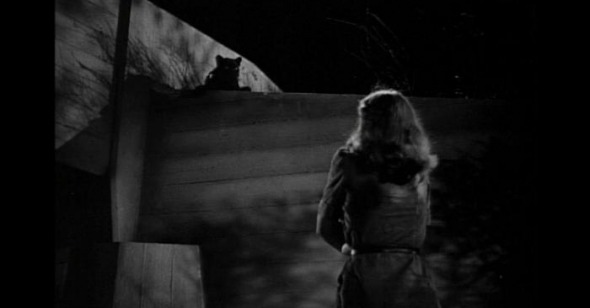First Night:
The Leopard Man
This year, Reverse Shot’s annual end-of-October “Great Pumpkins” series can finally get off on the right hobbled foot. We normally like to begin our Halloween recommendations with something of an assessment of the state-of-the-art of horror filmmaking, and since for the past few years the genre has become decidedly moribund, what should be a demonic celebration ends up something of a eulogy. Sounds funereally appropriate, but it’s been disappointing nevertheless. So we can begin with very good Monday box-office news: The latest installment of Gruesome, Poorly Edited Faux-Morality Tales an Incredibly Cynical Mini-Studio Churns Out for Easy Profit Every October (or if you prefer, Saw VI.....I repeat, VI!!!!) has been roundly spanked and sent to bed by Paranormal Activity. Normally these sorts of weekend money assessments come with bogus pronouncements (if, say, Ice Age 17 beats Duplicity, does it really mean that audiences prefer woolly mammoths to Julia Roberts?), but this one seems pretty clear-cut: Audiences seeking horror chose Paranormal over Saw; they craved fear over gore, mind over matter. Not that the former is without its flaws (and more on that later in the series this week), but it’s encouraging that word-of-mouth prevailed over retarded redundancy. Cross your fingers that any future Saw installments will go straight to DVD.
Although, as proven by the exclusive home-video release of Michael Dougherty’s Trick ‘r Treat this year (and Inside last year), what was once called the straight-to-DVD dumping ground is now rich territory for worthy horror films that studios didn’t know what to do with. Trick ‘r Treat, a not entirely successful but handsomely mounted piece of Halloween-porn (candy corn, autumn leaves, and jack o lanterns galore in this multi-narrative creepshow) was nearly legendary on the Fangoria circuit for the past two-plus years, after it was glimpsed at and adored by horror convention-goers, and then shelved by Warners. If its DVD release is anticlimactic (both due to the format and because the film itself is just a smidge underwhelming), it’s also encouraging that so many viewers demanded and craved something other than the horror dreck being forced upon us for years now.
That said, 2009 brought some true gifts, from the undeniably horror-tinged Coraline to Sam Raimi’s nearly triumphant (and even self-topping) return to horror, Drag Me to Hell, two of the best American films of the year. Those, plus the gonzo Orphan and the effective Paranormal Activity and 2009 might be a banner year—appropriate considering it’s the tenth anniversary of The Blair Witch Project, that harbinger of things to come, for better or for worse.
Despite all this talk of contemporary horror, this year’s first “Pumpkin” is from all the way back in 1943, and that perhaps comes as a lesson. Paranormal Activity largely subscribes to the usually true tenet that “less is more” in horror, likely because of its minuscule budget—and who else should we look to as the prime progenitors of that power-of-suggestion philosophy but producer Val Lewton and director Jacques Tourneur? While Cat People remains their masterpiece, The Leopard Man, made just one year later as part of their cheaply produced line of atmospheric terror films for RKO, trades in similarly terrifying imagery and perhaps an even more mysterious plot, one which is all the more disturbing for being somewhat plausible—in fact The Leopard Man is in many ways the first unofficial slasher film.
Set in a New Mexico town that’s seemingly always bathed in twilight, the film twists the “town gripped in fear” scenario with an unpredictable plot that kicks off when a fierce black leopard escapes from a seedy performance space, where its impresario unsuccessfully tried to incorporate it into the act. The beast then seems to wreak havoc on the locals, and three young females (pointedly from different classes and ethnicities) are murdered. As many have pointed out, Lewton and Tourneur could wring more throat-gripping suspense out of a single sequence of a woman walking down a deserted nighttime street than most filmmakers could manage in an entire film; Jane Randolph’s race to the bus stop in Cat People remains the definitive example of this, perhaps, but The Leopard Man has the most elaborate and unbearably elongated rendition, in which a young woman, sent out by her meat-fisted, demanding mother in the middle of the night to procure cornmeal, is followed on her walk home by an unseen beast. She pounds on the door for her disapproving mother to let her in—to no avail. A trickle of blood seeps under the door to the mother and the audience’s horror.
With its evocative Southwestern setting; its tenable environment of bored showgirls and showmen, museum workers and laborers; its exquisite sound design (especially the performer Clo-Clo’s rattling castanets, which seem to signify some sort of doom); and its silky-smooth shadows, The Leopard Man is a masterpiece of finely wrought atmosphere. It’s most unsettling aspect might be its systematic introduction of new characters: we follow their lives for just enough time to feel sympathy for them before they become victims; it’s what’s become the slasher template, albeit with more compassion and care than most contemporary films of the kind even try to muster. —Michael Koresky
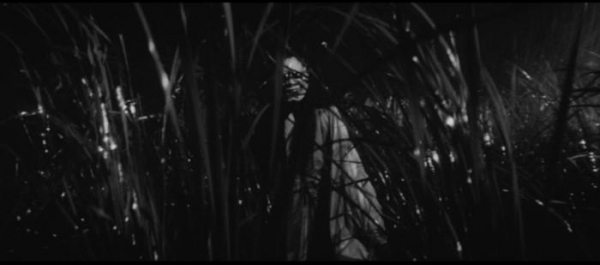
Second Night:
Onibaba
During last year’s “Great Pumpkin” series, I extolled the virtues of the face in horror cinema. It’s so simple, really: few things are as terrifying as the makeup of a face, whether forthrightly demonic or human but just a little . . . off. The doubling terror effect of the mask, then, is not only the fearful visage of the false face but also the possibility of the human one hidden underneath. Kaneto Shindo’s breathtaking Onibaba (1964) exploits this tension to masterful effect, building a slow rhythm to an unbearably frightening climax predicated on the terror of one mask—what it shows and what it conceals.
Though based on a Buddhist parable advocating women’s participation in religious ceremony, Shindo’s nightmarish period piece is an updated, more sexually frank morality tale, set in feudal Japan. With its subject matter and visuals, the film is strikingly similar to Rod Serling’s “The Masks,” a Twilight Zone episode that aired also in 1964, which dealt with age-old themes of the conflict between inward and outward beauty through its titular metaphor. In that short, however, the masks were omnipresent; they had more character than the characters themselves (a wretched family looking to inherit a dying relative’s money), necessarily. In Onibaba, however, Shindo takes a good long while to get us acquainted with his rascals, mainly a peasant mother and her daughter-in-law living in a marshy netherworld amongst reeds and tall grasses, constantly whipping in the wind. A war rages, though we never see anything past the frighteningly enclosed natural world in which they live; the mother’s son (and younger woman’s husband) is fighting, never to be heard from again. Yet this is no grieving mother and wife—whenever a samurai enters their reedy lair, they murder them, steal their armor and weaponry to sell them, and dump their bodies in a deep, cavernous hole in the earth.
As played by the scowling, witchlike Nobuko Otowa and the feral, wolfish Jitsuko Yoshimura, the old and young woman are monsters of desperation; yet their circumstances hardly make them sympathetic, as rarely do Otowa, Yoshimura, or Shindo angle for our compassion. When the missing soldier’s partner (a similarly amoral being) reenters their lives, a depraved love triangle brings them all the breaking point. Yet what truly sets the film off into nightmare territory is the sudden visit, in the film’s second hour, of a masked samurai in the middle of the night, asking the old woman for directions through the marsh. During their deliberate tête-a-tête, he taunts the old woman, saying that beneath his sneering, chin-jutted demon mask is the most handsome face she’s ever seen—yet he refuses to show it to her.
This is just the beginning of some of the most dreadful imagery I’ve seen. Through some diabolical machinations the mask haunts each of the other characters in different, unexpected, and horrific ways. A masterpiece of mood and slowly building tension, Onibaba deserves to be regarded as a forerunner to J-horror, even if it’s hardly a conventional ghost story (or even one at all—Shindo leaves it ambiguous). With little more than expert use of medium long-shot framing and exquisitely creepy lighting, Onibaba brings a plausible hell to earth. —MK
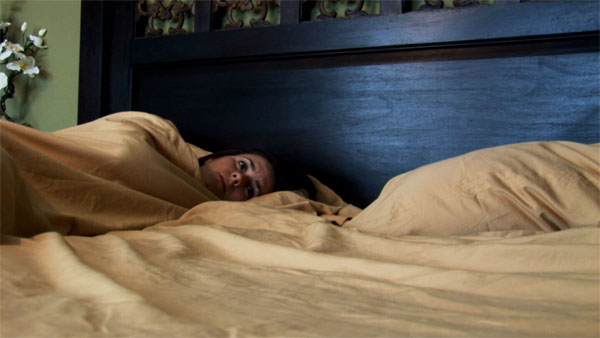
Third Night:
Paranormal Activity
No surprises here: Oren Peli’s Paranormal Activity, currently terrorizing people across North America, is genuinely scary. It’s also clunky, half-realized, and frustratingly compromised—none of which reduce its central, primal experiential heft. As far as inevitable comparisons are concerned, Paranormal Activity is no Blair Witch Project, as it misses out on that inadvertent masterpiece’s allegorical elegance (the film was downright Hawthornian in its portrait of mythical Americana seeking vengeance against interlopers) and technical coherence, not to mention its unwillingness to give up its ambiguities right to the final devastating image. One leaves Blair Witch with more questions than answers; Paranormal Activity has a more predictable shape, even if that shape also plays into elemental fears of nighttime. Day Night Day Night might have made for a more appropriate title in some ways: the former providing catharsis and relief, the latter bringing on irrationality and doubt—emotions mimicked in the experiences of the viewers. For all its damning quiet and general lack of razzle dazzle, Paranormal Activity lives or dies on the level of audience interaction; it plays off that immensely satisfying suck-in-your-breath-and-wait-and-exhale emotion that few artistic mediums can induce.
This is not to say that it necessarily rewards the viewers for their patience, or even properly confounds their expectations—the payoff is neither grandiose nor anticlimactic enough for this experiment to register as anything more than a surprising one-off. The relationship at its center—between the demon-haunted Katie (Katie Featherston) and the vaguely douchey Micah (Micah Sloat)—is plausibly acted and conceived, yet one could hardly call Paranormal Activity “character-driven”; we may spend all our time watching them freak out, fight, and make up, but the attempted intimacy of the film’s camcorder conceit only further distances them from us— they’re aware their emotions are being filtered through the many cameras Micah has set up around the house, so there’s an air of intentional performativity to their actions that makes them slightly less sympathetic. This is somewhat unavoidable, especially considering scenes in which Micah agrees to turn off the camera, such as when he’s apologizing to her for bringing a ouija board into the house despite her protestations. On the one hand it’s a relief that the characters (and filmmaker) are smart enough to not allow their most desperate relationship meltdowns to be captured on video; on the other hand, it creates an emotional ellipsis (they’re mad; the camera goes off and back on; they’ve made up) that distances them further from us.
The central unifying visual idea of Paranormal Activity is, even more than in Blair Witch, dubious: would Micah really keep filming his girlfriend day and night, especially when the demonic forces terrorizing her grow increasingly violent? As with Blair Witch‘s Heather, the one who wields the camera has to be painted as something of an asshole for the audience to believe in his or her directorial persistence. Yet with the earlier film, there seemed to be an implicit critique of sexist attitudes toward female filmmakers (by seizing upon power through the camera, her strength is deemed by the men around her—and the kneejerk audience—as witchlike), as well as just a general self-reflexivity about the process of constructing a narrative. Micah, on the other hand, seems more like an easy satiric target—the tech-head suburban male, filling his home with gadgetry that he finds more compelling than the woman he lives with, and with which, ultimately, he may be further harming her.
Nevertheless, despite the vaguely defined central couple and the somewhat sketchy offscreen demon that upends their lives (does it have pockets? then what’s with the photo in the attic?), Paranormal Activity is mightily effective, and perhaps the first haunted house film since Poltergeist to successfully make a bourgeois suburban tract home into the locus of genuine fear. The doors aren’t particularly creaky, there are no iron gargoyle gates, no ornate Gothic latticework. Instead, Oren Peli simply trains his camera on one room and lets our eyes wander over the space. From where will the threat come—the open door, with the terrifying darkness in the hallway beyond or on the bed with its central couple sleeping? Within or without? Millions of people are gladly watching a film in which they mostly are asked to stare at an unmoving shot of a silent room, just the slightest rumble on the soundtrack, and whether Peli is aware of his film’s unmistakable avant-garde vibe or whether he’s just very smart about severe budget limitations and this is simply his calling card for a big, noisy career, that’s still that’s pretty thrilling. —MK
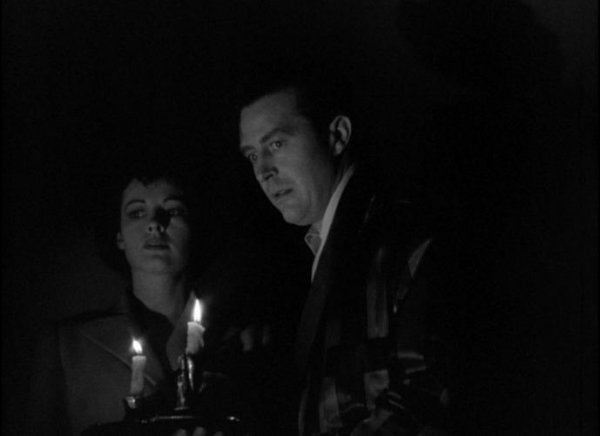
Fourth Night:
The Uninvited
Brother and sister Roderick and Pamela Fitzgerald (Ray Milland and Ruth Hussey) while on vacation in Cornwall, decide to purchase a large cliffside house. The place is lovely, eminently classy and full of light. Better yet, its owner, Commander Beech (Donald Crisp) is willing to part with the place for a song. All seems fine, great even. Except for one room on the second floor. It’s oddly cold in there, even when the sun’s shining in. It gets more frigid, perhaps even…menacing, when local girl Stella Meredith (a luminous Gail Russell) stops by for a little flirtation. An old village hag lurks around glaring ominously, and it’s clear Commander Beech knows more about the house than he’s letting on. It isn’t long before even stranger things start happening…
This is the set-up for Paramount’s 1944 stab at classic ghost story creepiness, The Uninvited, directed by Lewis Allen (who would go on to helm few features, but tons of Bonanza episodes), and sadly unremembered in most quarters. Some call The Uninvited the first Hollywood attempt at the haunted house genre (remember that most famous horror of the thirties revolved around the appearance of some kind of physical creature), and while I can’t validate this claim, I can attest to its effects on me: The Uninvited was the first film that raised the hackles on my neck and set my stomach roiling with queasy anticipation of scares to come, a far different, more pleasing sensation than that created by the teen splatterfests more prevalent in my youth. And all The Uninvited needed to fully freak me out: an empty room.
This kind of thing may sound perfectly rote now (films like The Others and The Orphanage surely owe a debt), but for 1944, even in the wake of the somewhat similar Rebecca, an Uninvited was something of a rare bird. There are the requisite seances, some terrific wind-on-candle and wind-on-curtain action (porn for ghost geeks), and an intractably complex genealogical back story to explain the malevolent presence ensconced in that room on the second floor—but what The Uninvited perhaps excels most at is striking that oh-so-fine balance between mood and character. Perhaps better put: it never lets its atmosphere overwhelm the people populating it, and the folks working their way to untangle the air of mystery always seem suitably in awe (yet still pluckily adventurous) of their surroundings and the potential dangers therein.
It’s amazing how often the old dictum that giving audiences folks to care about only increases rather than detracts from the scares gets ignored. Most people don’t shed tears over where their burgers come from, so parading the meat puppets into the abattoir yields a definitely diminishing return—can anyone name the protagonists of the last four Saw movies? Allen’s stellar cast works The Uninvited’s script, and hard (Victor Young, of Written on the Wind fame, provides an able assist on the score). But still, even after all these years, it’s that room I come back to. Empty, full of light, utterly terrifying. Proof positive that all you need to conjure good scares are big old houses and healthy doses of empty space. I’m creeped out just thinking about it. —Jeff Reichert
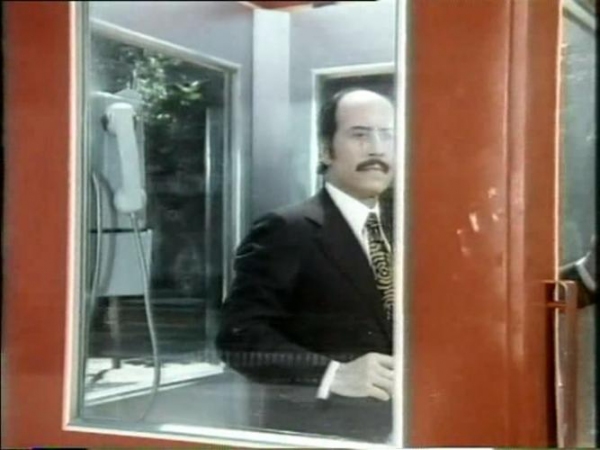
Fifth Night:
La Cabina
Looking back through Reverse Shot’s “Great Pumpkins” series, I was especially struck by those pieces that dealt with horror films experienced via television viewing. “How,” wondered Michael Koresky, in his appreciation of Salem’s Lot, “could something so emotionally disruptive come packaged with something so mundane as toothpaste and car ads?”
Reading that essay a year ago prompted me to scour the Internet for evidence of a television film I’d watched sometime in my tweenage years and thought back on many times since. Circa 1993/94, I was mainlining horror flicks at a rate of about five per week (mostly procured from the family-run video store around the corner from my parents’ house, whose owners had little compunction about renting R-rated titles to polite kids with exact change), but my cinephilia was still subordinate to my hockey fandom. And so those Saturday nights spent at home or babysitting for family friends followed a set pattern: hockey game first, movies later.
One evening, after watching the Maple Leafs lose to somebody or other, cruising past the local Latino channel, I stopped on what seemed to be a diverting image: a red, glass paneled booth containing a man, stowed on the back of a truck, stopped on the side of a rural highway, being stared at by a troupe of face-painted circus folk. I’d seen a few interesting “art” films on TLN in the past, so I stuck with it, wondering if I had fortuitously stumbled upon on some essential world-cinema thing.
I watched the presentation to the end, which came just 15 minutes (and two commercial breaks) later. What bothered me at the time was not the revelation of the truck’s ultimate destination, but the lack of attendant context. What had I missed? Who was the guy in the booth? Had I seen the ending of a feature film or an episode of a television series? I remember trying to mentally construct a first act for a story that ended with an ordinary-looking fellow being literally driven to the end of his existence, and thoroughly creeping myself out in the process.
Fifteen years later, following the invention of Google, I was able to type in a few key search terms (“phone booth” + Spanish?” + “horror film”) and voila: I discovered La Cabina, apparently a 32-minute, International Emmy-winning short by Antonio Mercero. A few more clicks, and I discovered that the film was viewable on somebody’s YouTube page and I watched it, for the first time, from beginning to end.
It’s not surprising that this second, pixelated, inherently distracted viewing couldn’t compete with the first, but I’m surely glad to have seen La Cabina in its entirety. Especially its expertly calibrated early movements, which describe how the unnamed, balding protagonist (Jose Luis Lopez Vazquez) becomes trapped in a phone booth in a town square after dropping his son off at the bus stop, and is transformed into a spectacle for the gathering citizenry. Mercero’s conventional, slightly mechanical technique—all crisp, lateral pans and deliberate slow zooms—gives the proceedings an appropriately slow-burn feel. And there are some wonderful details in the reaction shots of the gawkers, like how one man, who has brought a chair, magnanimously offers it to a stooped old woman so that she might better appreciate the unfolding human tragicomedy.
Even leaving aside the fact that I had already seen the film’s second half, I doubt I would have found it hard to guess where La Cabina was going: after a series of failed attempts to extricate the man from this seemingly impenetrable box (including the shoulder-first efforts of a big, righteously mustachioed Good Samaritan), four guys from what would seem to be the phone company arrive and bear the booth away on their truck. The aforementioned roadside interlude with the circus troupe comes after the film’s clear shock-cut highpoint, which I won’t spoil here but confirms that our hero is officially in for it, rather than the subject of some elaborate practical joke. Mercero’s overreliance on a score that pinballs from free jazz to Omen-esque choral bellowing is bothersome, but his craft is solid throughout, aided greatly by Vazquez’s impressively understated but plausibly desperate performance (most of his dialogue is simply mouthed through soundproof glass, but he gives us a sense of a real human being in peril).
The question, then, is what to “do” with La Cabina: is it a slightly creaky relic of short-form audience-goosing, or is there something more to its surreal “gotcha” machinations? Given La Cabina’s country of origin and date of release, it could be read as an oblique critique of Franco’s dictatorship (a “phone booth” film rather than “white telephone” film) with the phone company and their deceptively lethal construct serving as a means of both distraction and control. And were I an academic, I could probably erect a tortuous reading about how Mercero’s film about a man placed on public display anticipated the callow spectatorship of reality television.
But I think the film is simpler—and stickier than that: it appears to be about nothing more (or less) than the trap of aging. Note that Vazquez’s son enters and exits the booth with no difficulty after kicking his ball inside before departing on the school bus. Not the cheeriest conclusion to reach about a film so memorably experienced in one’s childhood, but as somebody whose favorite horror films have always been tinged by melancholy—from I Walked With a Zombie to Wendigo—it confirms the film’s place in my personal creepshow canon. —Adam Nayman
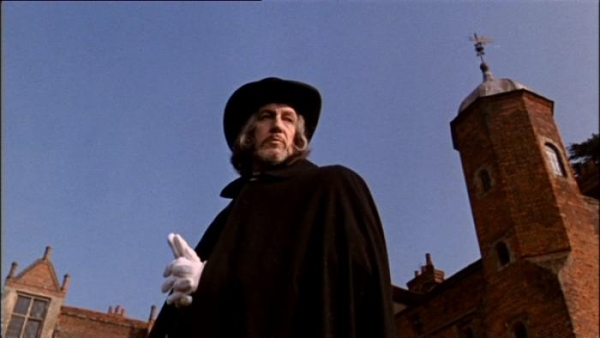
Sixth Night:
Witchfinder General
As with so many cinematic experiences in my misspent youth, Michael Reeves’s Witchfinder General (a.k.a. Conqueror Worm) was well-prepared for by copious before-the-fact study (thank you, Danny Peary); the film itself eventually functioned as confirmation of what had been read beforehand—thus no dark and unexpected encounter with primal fears here, I’m afraid. Yet that quality of remove almost seems appropriate for the quite astonishingly jaundiced eye which Reeves casts upon his horrors. Witchfinder General exists apart from the genre imperatives of shock, suspense, disgust, or prurience; rather, its ferocity and sometimes unbearable intensity is in the service of a vision of the world so willfully and unrepentantly corrupt that not even despair can penetrate.
Fictionalizing the real-life career of governmentally sanctioned “witch-hunters” Matthew Hopkins (a surprisingly restrained, slyly intelligent Vincent Price) and his brutal assistant John Stearne (Robert Russell) as they ply their bloody trade across the Roundhead-controlled territory of East Anglia during England’s Civil War in the mid-17th century, Witchfinder General consistently turns its scorching gaze from these icons of obvious evil to the society that allows them to perpetrate their profitable acts of torture and murder. Though they are the agents of an authoritarian state—embodied in the gluttonous Cromwell (Repulsion’s Patrick Wymark, sporting a wart-riddled face), who chortles over his armies’ victories and accounts them “a triumph for true godliness” with a knowingly hypocritical wink—Hopkins and Stearne are aided and abetted in their depredations by the very people who are under their boot heel: the local townspeople whose prejudice, ignorance, or sheer motiveless malice leads them to accuse their neighbors of relations with the Devil.
Nor are Hopkins and Stearne immune to that same overriding law of force: already pursued by the vengeance-seeking soldier Richard Marshall (Ian Ogilvy) after raping his fiancée (Hilary Dwyer) and burning her guardian as a sorcerer, Hopkins and Stearne find themselves set upon in the forest by Marshall’s Roundhead comrades, who are out “borrowing” horses to aid the parliamentary cause. What makes this scene remarkable is that Reeves does not have the audience delight in our villains’ reversal of fortune, but casts the same coldly furious eye upon this licensed brigandage as upon the horrors perpetrated by the witch hunters. The benighted inhabitants of this world—including our righteously aggrieved “heroes”—are bound together by a common malignancy of which Hopkins and Stearne are only the most flagrant examples. The bloody whirlwind they ride will claim them in their turn—which it does, with a thoroughly unwelcome vengeance, in the film’s sickening denouement in the bowels of a castle.
What validates this unrelentingly bleak vision is Reeves’s almost paradoxical eye for beauty. Witchfinder General’s world is too inherently ugly to require further uglying up: instead, Reeves fills his widescreen frame with gorgeous stretches of English country landscape, electrified by the rush of galloping horses. Rather than easily contrasting pastoral beauty and human brutality, Reeves fuses the one with the other: in the film’s opening shots, a flock of sheep reclines peacefully while a gallows is erected on a grassy hilltop. Similarly, the force and intensity of Reeves’s filmmaking leavens excitement with cold dread and numbed revulsion. The very reasons for which we watch this fare—the violence, the grue, the extremity of the images before us—are here delivered with such merciless skill that they break through the distancing wall of “enjoyment” and turn our gaze back. As ever more “witches” are tortured and burned in town squares and screams of pain and fear fill the soundtrack, Reeves cuts to the placid spectators of these atrocity exhibitions: none of them celebratory, a few perhaps vaguely disdainful or disapproving of the goings-on, but keeping their better instincts (if any be left) concealed behind a mask of distanced curiosity. No wonder that the last words of the film are “God help us”—and little surprise that that plea is immediately swallowed by the unending shrieks which even the rolling of the end credits cannot silence. —Andrew Tracy
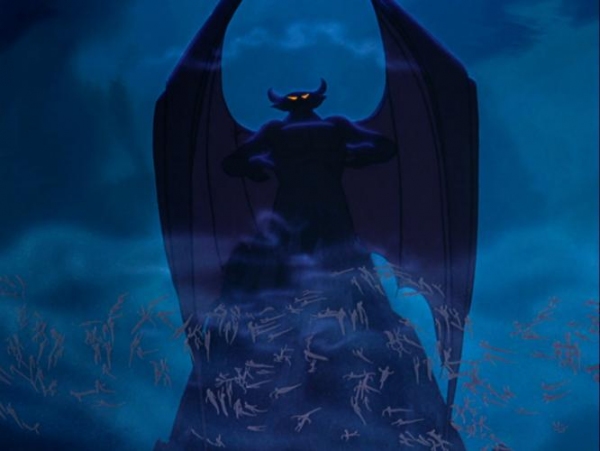
Seventh Night:
Fantasia's "Night on Bald Mountain"
Now that you’ve been sufficiently scared all week, it’s time to party. Rarely has there been a better celebration of the spirit of Halloween than the magnificently unsettling “Night on Bald Mountain” segment from Walt Disney’s 1940 labor of love, Fantasia. Putting aside obvious narratives of how this terrified many a tot (coming after nearly two hours of plotless, dialogue-free, near abstract animated sequences, this piece de résistance sent kids over the edge, often from boredom into manic freak-out mode), this perfectly petrifying short film, based on Modest Mussorgsky’s 1860 composition, is simply the most effective hand-drawn spookshow of all time.
Without a doubt there’s never been anything quite so spectacularly evocative of profane paganism and spiritual unrest on film, exemplified not only by the onslaught of demons and ghosts that dance around a German expressionist-designed Bavarian village late one Walpurgis Night, but of course also by Chernabog, the horned, mountaintop Slavic God of evil that makes the dead his abused playthings. Designed by the brilliant Bill Tytla, Walt Disney’s go-to animator for objectionable characters (Grumpy, Pinocchio‘s mean Gypsy puppeteer Stromboli), Chernabog is powerful yet wretched, a full-fledged character rather than simply a personification of pure evil, surprisingly neurotic despite his frightening sorcery and terrible musculature. For when the bell tolls morning, it tolls for him, a bright flash of sacred dawn shining across his shamed face like the light of truth . . . of course there’s nowhere to go but All Saint’s Day.
Once Chernabog makes his appearance, wings outstretched in a satanic pose lifted directly from F.W. Murnau’s Faust, “Night on Bald Mountain” becomes a dazzling freeform poem of unrest. After the demon king’s hands glide over the village, their ghastly shadows turning out house lights one by one, the monsters come out: transparent specters and goblins rise out of graveyards and murky ponds, eerie hooded figures glide out of hangman’s nooses, bare-breasted harpies and skulls with wings fly at the camera, erotically undulating flames contort into horned pigs and goats, all set to Mussorgsky’s slow-building dervish. How all of this was achieved by the brilliantly inspired animators at the Walt Disney Studios in 1939 is nothing short of miraculous: an outpouring of creative camera and animation effects, including the one-of-a-kind visual sensation achieved by reflecting drawings of unmoving ghosts in rounded pieces of tin and the sinister use of the multiplane camera to move in on a hushed hilltop grave canopied by a crooked tree.
The effect this had on a fresh young mind such as mine is frankly immeasurable—it’s a Silly Symphony gone horribly wrong, an amazingly sustained paean to bad behavior that even Schubert’s “Ave Maria” can only try to dilute. This beautifully otherworldly cartoon remains my favorite Halloween jubilee, in which spiritual restlessness equals the restless spirit of youth, dancing together in a frenetic yet ultimately harmless festival of freedom. When Chernabog makes his final reach of defiance to the skies before he must fold himself back into the mountain and give up his evil ecstasy for another year, it’s surprisingly identifiable and poignant. Like the morning after Halloween, order is restored, the revelry is over, and life goes back to regrettable normalcy. —MK
